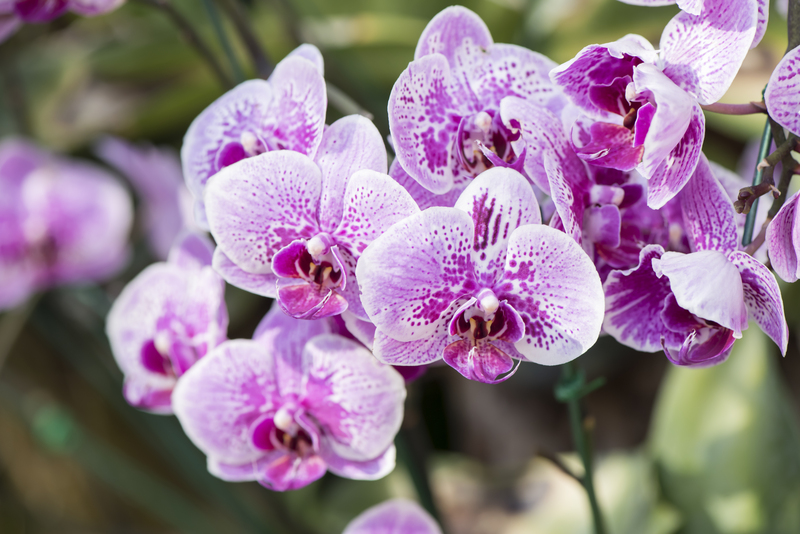Revitalize Your Home with Vertical Gardening
Posted on 26/09/2025
Revitalize Your Home with Vertical Gardening: A Complete Guide
Are you looking to transform your living space with lush greenery, even with minimal floor space? Vertical gardening is the answer! In this comprehensive guide, we'll explore how to revitalize your home with vertical gardening, offering insights, ideas, and practical tips that anyone can implement. Whether you're a seasoned gardener or just starting, discover how vertical gardens can bring new life and beauty to your home.

What is Vertical Gardening?
Vertical gardening is the practice of growing plants upward rather than outward, using structures such as trellises, shelves, walls, or towers. This innovative method maximizes limited space, making it ideal for small apartments, balconies, patios, or urban environments. With vertical gardening, you can create stunning green displays while enjoying the benefits of nature indoors or outdoors.
- Efficient use of space: Perfect for tight or limited living spaces.
- Improved air quality: Plants naturally purify the air by absorbing pollutants and releasing oxygen.
- Aesthetic appeal: Adds visual interest and lush beauty to any home environment.
- Reduced maintenance: Less bending and weeding compared to traditional gardens.
- Versatility: Grow flowers, herbs, or even vegetables vertically!
Why Choose Vertical Gardening to Revamp Your Home?
Revitalizing your home with vertical gardening offers a multitude of advantages. Let's dive into the key reasons why adopting this modern approach can completely refresh your living spaces:
1. Maximize Limited Space
In urban areas, space is often at a premium. Vertical gardens utilize upward space on walls, fences, or even windowsills, allowing you to create a *green oasis* without sacrificing precious square footage.
2. Create Stunning Visual Focal Points
Vertical gardens serve as living art pieces, instantly drawing the eye and enhancing interior design. With strategic placement and a variety of plant colors and textures, you can design a space that feels fresh, lively, and original.
3. Boost Mental Well-being
Studies have shown that proximity to plants can reduce stress, improve mood, and increase productivity. Vertical gardening infuses tranquility into your home and brings you closer to nature, no matter where you live.
4. Grow Fresh Produce and Herbs
One of the most exciting aspects of vertical gardening is the ability to grow your own herbs, vegetables, and fruits. Imagine plucking fresh basil or strawberries right off your living wall, year-round!
5. Enhance Indoor Air Quality
Plants naturally filter toxins and improved humidity -- essential for healthy, comfortable living environments. With a vertical garden, you actively purify the air while adding lush beauty to your home.
Vertical Gardening Ideas for Every Space
There are countless ways to incorporate vertical gardens into your home, regardless of your available area, style preference, or budget.
Wall-Mounted Planters
Wall-mounted planters come in a wide range of materials, sizes, and designs. They can be arranged in creative patterns, acting as living wall art. Options include:
- Modular panels that can be filled with succulents or herbs
- Hanging pockets made from felt or recycled fabric for lightweight plants
- Ceramic or wooden planters fixed directly to the wall for a bold visual statement
Pallet Gardens
Repurposed wooden pallets are an affordable and eco-friendly way to establish a vertical garden. Sand and paint a pallet, staple landscape fabric to the back and sides, and fill the pallets with soil and your choice of plants. Pallets are perfect for small herbs or annual flowers.
Ladder or Leaning Shelves
Convert an old ladder or create leaning shelves against a wall to display a variety of potted plants. This is a fantastic moveable option for renters or those who want flexibility in their garden design.
Hanging Gardens
Use ropes, chains, or hooks to suspend planters from the ceiling or window frames. This creates an airy, cascading effect -- ideal for trailing or vining plants such as pothos, philodendron, or string of pearls.
Trellis Walls
Install a wooden or metal trellis on an empty wall or fence. Climbing plants like ivy, jasmine, or clematis will naturally grow upward, covering the structure with greenery over time.
Tower Gardens
For maximizing vertical growth in tight spaces, consider a tower garden with stacked planters or hydroponic systems. These are especially effective for growing edible produce like lettuce, herbs, strawberries, and tomatoes.
Best Plants for Indoor Vertical Gardens
Choosing the right plants is crucial for the success of your vertical garden. Here are some top selections that thrive indoors and contribute to a lush, vibrant atmosphere:
- Ferns: Add texture and thrive in humid environments
- Pothos: Hardy trailing plant ideal for beginners
- Philodendron: Tolerates low light and low maintenance
- Spider Plant: Naturally purifies air and multiplies easily
- Succulents: Low water needs and perfect for bright spots
- Herbs: Basil, thyme, mint, or oregano for a fragrant, edible garden
- Orchids: Exotic blooms for a splash of color
When assembling your vertical garden, mix different plant forms, colors, and sizes for a dynamic, layered look.
DIY Vertical Gardening: Step-by-Step Setup
Ready to revitalize your home with vertical gardening? Follow these simple steps to bring your green wall to life:
- Choose Your Wall or Location: Select a spot with adequate light. South-facing walls are excellent for most plants.
- Select a Structure: Decide between shelves, pallets, panels, or hanging systems. Make sure the structure is secure and can bear the weight of wet soil and mature plants.
- Prepare the Wall: Ensure protection from moisture or dripping water, especially indoors. Use waterproof paint or backing if necessary.
- Plant Selection: Opt for plants matching the site's light and moisture conditions. Mix upright and trailing varieties to fill in all spaces.
- Soil and Irrigation: Use lightweight potting mix and consider drip irrigation for convenience. Indoor systems may benefit from self-watering planters to avoid messes.
- Assembly: Install the chosen structure and add plants, arranging taller varieties toward the top and trailing or bushy plants toward the middle and bottom.
- Ongoing Care: Regularly water, fertilize, and trim your plants. Monitor for pests or disease, and enjoy the ongoing transformation!
Tips to Keep Your Vertical Garden Thriving
To make the most of your new vertical garden, keep these key pointers in mind:
- Monitor Moisture Easily: Because vertical gardens dry out faster, check soil moisture often, particularly for wall-mounted and hanging installations.
- Rotate and Prune Regularly: To promote even growth and prevent hazards, rotate pots and prune plants as needed.
- Light Matters: Place your installation where it receives the right amount of natural or artificial light according to plant needs.
- Consider Fertilization: Plants in vertical systems have limited soil and nutrients, so feed them regularly with diluted liquid fertilizer.
- Watch for Pests: Keep an eye out for aphids, spider mites, and fungus. Indoor gardens may be susceptible to different pests than outdoor ones.
Vertical Gardening Trends to Inspire Your Design
Get creative with the latest vertical gardening trends that blend functionality with design excellence:
- Living Moss Walls: Evoke natural serenity with low-maintenance, sound-absorbing moss panels.
- Green Walls for Kitchen Backsplashes: Grow herbs and small vegetables where you cook for easy harvesting.
- Geo-patterns with Planters: Arrange your vertical garden in geometric patterns for modern aesthetics.
- Mixing Materials: Combine wood, metal, and ceramics for a contemporary look that also supports plant health.
- Smart Gardens: Use automated hydroponic or irrigation systems managed from your smartphone for ease of care.
Eco-Friendly Benefits of Vertical Gardening
Revitalizing your home with vertical gardening has positive environmental impacts, such as:
- Insulation: Green walls help regulate indoor temperature, lowering energy use.
- Biodiversity: They attract pollinators, beneficial microbes, and support urban wildlife.
- Rainwater Use: Outdoor vertical gardens can absorb rainwater, reducing runoff and soil erosion.
- Reduced Landfill Waste: Upcycle pallets, old furniture, or containers as garden structures.
Challenges and How to Overcome Them
While vertical gardening offers many benefits, a few challenges may arise:
- Moisture management: Prevent leaks and wall damage indoors with waterproof liners and trays under planters.
- Weight limitations: Use lightweight mixes and containers, and ensure walls or supports are properly anchored.
- Plant selection: Choose species that thrive in your specific light, humidity, and temperature conditions.
- Access for maintenance: Install gardens at a convenient height and width to allow for easy care.

Revitalize Your Home with Vertical Gardening Today!
There's no better time than now to breathe new life into your space. With the right approach to vertical gardening, anyone can enjoy vibrant greenery and all its benefits--right at home!
From lush living walls that make a bold statement, to compact herb towers that bring flavor to your kitchen, vertical gardening is redefining how we decorate and live with plants. Start planning your vertical garden project today and watch as it transforms both the look and feel of your home.
Frequently Asked Questions About Vertical Gardening
- Q: Can I create a vertical garden in a small apartment?
Absolutely! Use wall-mounted planters, hanging shelves, or compact tower systems to fit any space. - Q: What is the easiest plant for beginners?
Pothos and spider plants are very forgiving and thrive in almost any indoor environment. - Q: Do vertical gardens need a lot of sunlight?
Most plants prefer bright, indirect light, but many shade-tolerant varieties can succeed in lower light as well. - Q: Is vertical gardening expensive?
It can be budget-friendly! Upcycle containers and use DIY methods, or invest in modular systems for more extensive projects.
Conclusion: Embrace the Vertical Garden Revolution
With a commitment to creative use of space, choosing the right plants, and a bit of ongoing care, you can harness the power of vertical gardening to revitalize your home. From improving air quality and mental well-being to adding color, texture, and life to your interiors or exteriors, the vertical garden trend is here to stay.
Don't wait--start your journey to a greener, fresher home today by revitalizing your home with vertical gardening!

